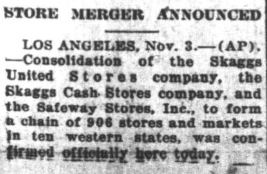It was great to see more on Safeway history in the paper today!
 |
| Safeway history in the Sunday paper |
By accident or intent, today's history column builds on a couple of previous pieces here:
- "Safeway's Movement in Town Tells us Lots about Salem's History" (2014)
- "Christo's and Capital Market: Old Safeways Still Useful, Tell Development Story" (2015)
I had looked at the movement out south along Commercial Street, and this new take adds some additional information. In particular I had missed their origin locally in the Skaggs United Chain.
 |
| June 3rd, 1921 |
Skagg's had opened a new store here in 1921 and five years later Skaggs and Safeway merged.
 |
| November 4th, 1926 |
They started advertising as Skaggs Safeway shortly after the new year.
 |
| January 25th, 1927 |
Reading about this connection was very helpful.
But a quibble. The piece does not give sufficient attention to autoism.
The post WWII economy saw a nationwide housing boom. This seems to have manifested itself locally in the development of South Salem neighborhoods. Safeway moved south to accommodate some of this population shift. In 1955, a brand-new store was opened at 2575 Commercial Street (Commercial and Boice Streets).
In the aerial shot that accompanied the piece, you can see the big parking lot. It was the car, and the more sprawling development pattern it enabled, not a "housing boom" in and of itself, which might also have been satisfied by apartment blocks in a more compact city, that prompted the shift.
We cannot understand the movements of the store, as well as the particular forms of housing, without seeing transportation. But the dominance of our autoism as a cultural system likes to hide itself as background when it fact it is foreground. (So that's an important reason why we try to foreground it more here.)
And the close may miss on the significance of the Urban Growth Boundary and our climate needs to reduce driving. Big box retailing is also in flux, and grocery stores will not be immune.
While it may seem unfathomable today, at the time of its planning, the new location so far south [5660 Commercial St SE] was a bit of a gamble, banking on an increase in residential growth out south. Still going strong after 19 years, it would seem that the gamble paid off. Although if history does indeed repeat itself, it may be getting close to time for a new store even further south?
While it is not certain, it seems increasingly less likely that we will keep building bigger boxes further out on the edges of town for new grocery stores.
Previously here:
- On the area just to the east of the store at 2575 Commercial St SE. You can see in the aerial the auto camp and American Legion Club on the 1950 Sanborn map. "Italianate Smith-Ohmart House of 1870 up for Historic Design Review." The house is concealed in the Oak grove on the aerial.
- On a downtown Fred Meyer, "Early Fred Meyer Storefront Restoration; Notes on Depot Addition" and "More on 148 North Liberty as Early Fred Meyer."
- "World War I Prompts Changes in Retail Transportation" on changes from credit to cash, and from delivery to cash-and-carry. The car is very much at the center here.
- On the new Howard Street Charter School's building, "Veterans Hall Litigated, Abandoned Before Bergs Market at New Howard School Site."
- And all grocery store history posts here.


2 comments:
I emailed the author and told her as much. Plus Safeway was chasing the wealthier, white households. And I have a real problem with a business model that says we will build a store with the knowledge that we will abandon it in 20 years. How sustainable is that? For the planet,I mean.
You are right to point out the problem with a 20-year planned obsolescence!
At the same time, the Safeway stores have all proved to be useful, and it may be that the grocery store box as a generic type is relatively more flexible:
Christos, Capitol Market, and Northwest Hub are all in early Safeway stores. School District HQ and Wilco are both in newer stores.
The Department of Energy was, and now Howard Street Charter School is, in another mid-century grocery store.
Newer and larger stores may not be as easily repurposed, however.
Still, the basic form may not be as "disposable" as it might have seemed, and there is some interesting nuance and complexity to that 20-year horizon, at least historically.
Post a Comment